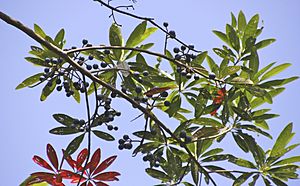Blue quandong facts for kids
Quick facts for kids Blue quandong |
|
|---|---|
 |
|
| Elaeocarpus grandis at Mount Mellum | |
| Scientific classification | |
| Genus: |
Elaeocarpus
|
| Species: |
grandis
|
The Elaeocarpus grandis, often called blue quandong, blue fig, or silver quandong, is a type of flowering plant. It belongs to the Elaeocarpaceae family and grows only in eastern Australia. This is a very large tree with special wide roots at its base. It has long, oval-shaped leaves with tiny teeth, greenish-white flowers that grow in clusters, and round blue fruits.
Contents
Description
The Blue Quandong is a tall tree that can grow up to 35 meters (about 115 feet) high. Even young trees have large, strong roots at their base. These are called buttress roots because they look like the supports on a building. They help the tree stand firm.
Its leaves are shaped like long ovals, usually 8 to 19 cm (3 to 7.5 inches) long. They have many small, regular teeth along their edges. Before they fall off, these leaves turn a bright red color.
The flowers grow in hanging clusters, about 6 to 10 cm (2.5 to 4 inches) long. Each flower hangs on a small stalk. The flowers have five sepals (leaf-like parts that protect the bud) and five greenish-white petals. These petals are about 15 mm (0.6 inches) long and have small frilly tips. Each flower has many stamens (the parts that make pollen).
This tree flowers in autumn. Its fruit is a round, blue drupe, which is a type of fruit with a hard pit inside, like a peach. The fruit is about 2 to 3 cm (0.8 to 1.2 inches) across and has a bumpy, sculptured pit.
Taxonomy and Naming
The Blue Quandong was first officially described in 1860. A scientist named Ferdinand von Mueller wrote about it in his book Fragmenta Phytographiae Australiae. He found samples of the tree near the Pine River in Australia.
The name Elaeocarpus grandis is widely accepted in Australia. However, some plant experts think it might be the same species as Elaeocarpus angustifolius.
Distribution and Habitat
Blue quandong trees grow in rainforests. They also like to grow along moist, bushy riverbanks. You can find them from Cooktown in far north Queensland down to the Nambucca River in northern New South Wales. They can grow at different heights, up to 1,100 meters (about 3,600 feet) above sea level.
Ecology
The blue fruits of the Blue Quandong are a favorite food for many animals. Birds like the Australian brushturkey and the large southern cassowary enjoy eating them. Flying foxes, which are a type of bat, also feast on these fruits.
Uses
Use as food
Long ago, Indigenous Australians ate the fruit of the Blue Quandong. They would eat it raw or sometimes bury the unripe fruit in sand for a few days. This made the fruit sweeter and tastier. Early European settlers also used the fruit to make jams, pies, and pickles.
Other uses
In the past, the wood from the Blue Quandong tree was very useful. People used it to make furniture and for building things. It was also used to make racing sculls (boats) and oars. Aboriginal people also used the hard pits from the fruit to make necklaces.
Images for kids
-
fruits (drupes) on the tree
See also
 In Spanish: Quandong Azul para niños
In Spanish: Quandong Azul para niños










